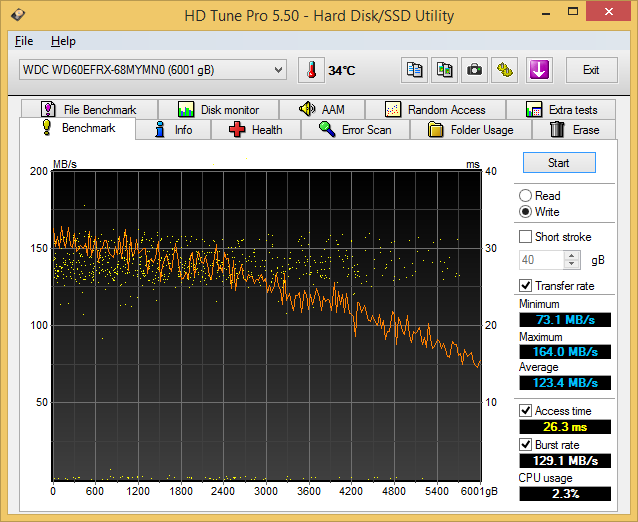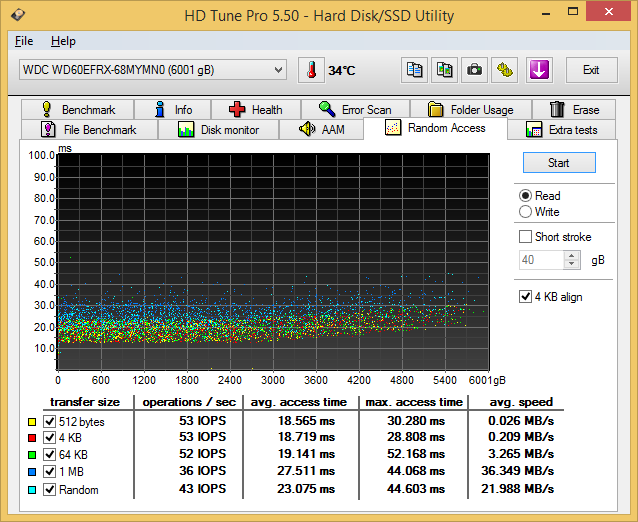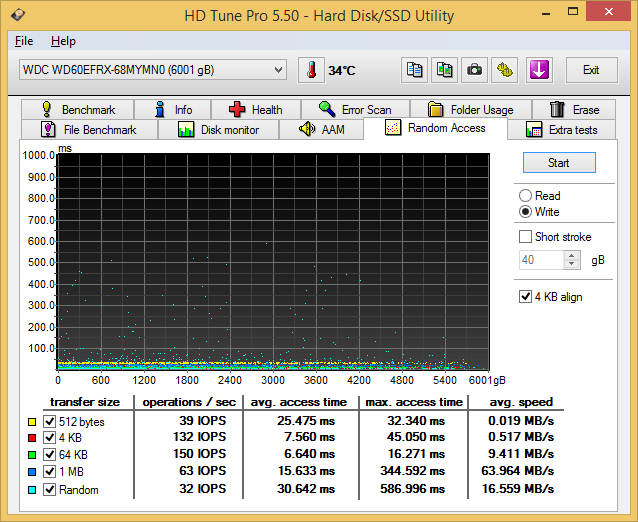6 TB NAS Drives: WD Red, Seagate Enterprise Capacity and HGST Ultrastar He6 Face-Off
by Ganesh T S on July 21, 2014 11:00 AM ESTPerformance - Raw Drives
Prior to evaluating the performance of the drives in a NAS environment, we wanted to check up on the best-case performance of the drives by connecting them directly to a SATA 6 Gbps port. Using HD Tune Pro 5.50, we ran a number of tests on the raw drives. The following screenshots present the results for the various drives in an easy-to-compare manner.
Sequential Reads

The Seagate Enterprise Capacity drive, as expected, leads the benchmark numbers with an average transfer rate of around 171 MBps. The HGST unit (142 MBps) performs better than the WD Red (126 MBps) in terms of raw data transfer rates, thanks to the higher rotational speed. The burst rate of the Seagate drive is also higher. In effect, the higher amount of cache memory on the Seagate drive helps it to perform well in this test.
Sequential Writes

A similar scenario plays out in the sequential write benchmarks. The Seagate drive leads the pack with an average transfer rate of 168 MBps followed by the HGST one at 139 MBps. The WD Red's 123 MBps is the slowest of the lot, but these results are foregone conclusions due to the lower rotational speeds in the Red.
Random Reads

In the random read benchmarks, the HGST and Seagate drives perform fairly similar to each other in terms of IOPS as well as average access time.
Random Writes

The differences between the enterprise-class drives and the consumer / SOHO NAS drives is even more pronounced in the random write benchmark numbers. However, the most interesting aspect here is that the HGST Ultrastar He6 wins out on the IOPS for 512B transfers due to its sector size. Otherwise, the familiar scenario that we observed in the previous subsections play out here too.
Miscellaneous Reads

HD Tune Pro also includes a suite of miscellaneous tests such as random seeks and sequential accesses in different segments of the hard disk platters. The numbers above show the HGST and Seagate drives matched much more evenly. The cache effects are also visible in the final graph.
Miscellaneous Writes

Similar to the previous sub-section, we find that the Seagate and HGST drives quite evenly matched in most of the tests. The HGST drive does exhibit some weird behaviour with the burst rate test and the Seagate one with the 8 MB random seek tests, while the Red is consistent across all of them without being exceptional.
We now have an idea of the standalone performance of the three drives being considered today. In the next section, we will take a look at the performance of these drives when subject to access from a single client - as a DAS as well as a NAS drive.










83 Comments
View All Comments
ganeshts - Tuesday, July 22, 2014 - link
I have seen graphs in preparation where some set of values are just dwarfed by the higher values from other result sets. What you see is basically a set of clustered points at the base (very close to the X axis), while there is a nicer graph with clearly spaced out values for the other result set in the middle of the graph. Trust me, I have done this and it doesn't look nice or present meaningful information to the readers.Fjodor2000 - Tuesday, July 22, 2014 - link
Are there any measurements and comparison of the noise levels for these new WD HDDs?Particularly for the WD Red 5 and 6 TB HDDs this would be interesting to know, and how they compare to the 4 platter WD Red 4 TB HDD.
stevenrix - Tuesday, July 22, 2014 - link
Any kind of hard-drive will fail sooner or later, but the quality of hard-drives has been horrible for the last 5 years or maybe more, which is unfortunately expected since bigger hard-drives increase MTBF. The professional drives seem to fail faster than consumer drives from what I've seen: a 1 tb SAS drive 3.5 inch 15K speed can fail just about 2 months after purchasing it, because the platters spin faster and they are no other additional technical enhancements on these drives compared to consumer drives.Out of probably 200 drives I've used over the last 2 decades, only one never failed and it is a WD 73 Gb in EIDE. After seeing so many failures, I decided to use RAID levels and backup my data on backup tapes.
There is also one important point: the replaced drives in the US is refurbished most of the time, while that's not the case in Europe, unless this has changed. Once you get a replacement, you can be sure that the drives will fail in less than 1 year, so those companies are defeating the purpose, replacing a drive by an old hard-drive that has been refurbished to meet satisfactory criterias, that is not good customer service without mentioning those monopolistic companies. A little bit more competition should be good for us consumers.
The only company so far I've been satisfied is with HGST.
jabber - Wednesday, July 23, 2014 - link
I live in Europe. Had a WD 75GB Raptor fail on me after a couple of years. The replacement was marked as 'Recertified'.That replacement is still going nearly 7 years later as one of my stunt drives. You know the one or two drives you have laying around that get tossed into all sorts of projects. Just keeps on trucking.
Jorsher - Thursday, July 24, 2014 - link
A lot of people seem to assume that new is better than "refurbished."What they don't realize is that refurbished products tend to go through a much more thorough testing process than brand new products. This is just based on a couple consumer electronics companies I've worked at, with the largest being LG. New products go through a relatively quick test, and in many cases they only test a few out of each batch. Products that are sent back due to warranty are first put through a thorough test to determine what problems it has, then it's decided if it's worth repairing or not, then it's repaired, then it's put through another test -- for every one.
Since those experiences, I now buy factory-refurbished when possible.
hwnmafia02 - Friday, July 25, 2014 - link
Man those companies provided you with such wonderful hardware and you can't even include the logos for each in the thank you section? Come on, now...Elmeransa - Saturday, July 26, 2014 - link
Running 8*3TB WD Red since 2 years back, no issues at all in raid5Haravikk - Monday, July 28, 2014 - link
One thing that wasn't mentioned was noise; while there were several reasons for my choosing WD Reds for my Synology NAS (a DS212j with two 3tb disks simply concatenated for capacity since it's already a redundant backup). My main decision factors were that the WD Reds were a reasonable price (not too far above greens), but are also exceptionally quiet; except for when they're initially spinning up or spinning down I can't even hear them over the sound of the NAS' fan, and the fan is barely audible to begin with. Meanwhile I've known enterprise drives that are very noisy, as well as various desktop disks that sound like someone pouring gravel (during normal operation).swansearecovery - Monday, July 28, 2014 - link
This post includes a great article on hard drives, truly brilliant. After reading the information given I have no second thought on that you people are also very good experts in handling the cases of Data Recovery from Hard Drive as well.http://www.swanseadatarecovery.co.uk/hard-drive-re...
intiims - Tuesday, December 30, 2014 - link
Great topic with a lot of usefull information,If You want To Read More About External Hard Drives just visit
http://www.hddmag.com/